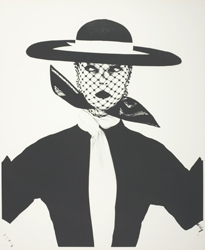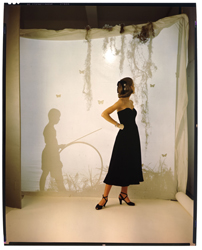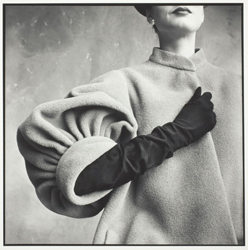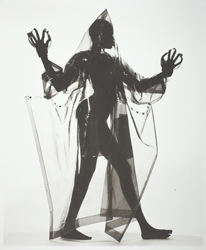Irving Penn's ultra-high-contrast photograph of model Jean Patchett, published on the cover of Vogue in April 1950, marked a sharp departure for the magazine: it had not run a cover in black-and-white since switching to color in May 1932. The starkly geometricized image showed a dress inspired by French fashion designer Christian Dior, whose New Look collection of 1947 had effected a sea change in fashion. New Look, a term coined by Harper Bazaar editor-in-chief Carmel Snow, featured narrow shoulders, tiny waists, and full skirts to give a buoyant silhouette sharply at odds with the reserved and utilitarian style of wartime fashion. Patchett's pose—hands on hips, frontal view—and the reduction of tones to nearly pure black and white accentuate this silhouette to the utmost.
It was with the photographs from the 1950 Paris collections that Penn found his trademark style in fashion photography and revolutionized the field. The graphic style and sharp visual results he achieved in that series marked a dramatic shift from his own earlier work, which had used theatrical backgrounds and unifying themes to present the fashions.
Early Fashion Photographs, 1944–1949
Shortly after he published his first cover photograph in October 1943—a still life of fashion accessories—Penn was given his first assignments to photograph models wearing fashions made popular during World War II. Penn's first fashion series were typically organized around a theme or event that acted as context for the garments. Penn describes his early work as "Situation photographs. Roots in theatre... As used to show contemporary fashions."1 For example, the August 1946 feature Playclothes presented models standing in front of a sheer curtain that shows a silhouette of a child engaged in a variety of games, perhaps a suggestion of a return to a more innocent and domestic life without war.
Additionally, when Penn photographed model Dorian Leigh for the February 1947 feature American Beauties, he included several still life elements, including a bowl of citrus fruit next to a still life print of the same, a pomegranate on the floor, and a clock marking time above the model's head.
1950 Paris Collections
Under the instruction of Alexander Liberman, Penn visited Paris in 1949 to observe the release of the Paris collections and get a better understanding of the fashion world. When Vogue sent Penn back to Paris in July 1950 to document the unveiling of that year's fall collections, he was commissioned to photograph the fashions in black-and-white. Although by this time the commercial and advertising world was favoring color, black-and-white photography suited Penn's graphic and modern aesthetic as well as the fashion itself. Postwar fashion focused on construction, featuring full, feminine silhouettes and luxurious fabrics—made available in the postwar boom—to create volume, shape, and texture.
In order to capture these garments Vogue secured Penn a studio space in Paris, which he later described in a notebook entry:
Always sensitive to possibilities, Alexander Liberman arranged for me in Paris the use of a daylight studio on the rue de Vaugirard, on the top floor of an old photography school. The light was the light of Paris as I had imagined it, soft but defining.
We found a discarded theater curtain for a backdrop. As it turned out, 1950 was the only year we were able to have couture clothes during daylight hours at the height of the collections. Clothes were hurried to the studio and back to the salons by cyclist.2
Penn's reportage of the unveiling of the collections owed its success partly to the relationships forged between editors, art directors, designers, and models. Penn had great respect and admiration for the models, whom he respected and admired for their "early professionalism" and "genuine style,"3 and declared them as being "the most receptive vessels of a strong projection of an editorial concept."4 Prior to traveling to Paris in 1950, Penn married Lisa Fonssagrives, one of the most famous models of the time and the subject of several iconic photographs by Penn.
Although Penn preferred certain designers, among them the Spanish couturier Cristóbal Balenciaga, he worked to maintain objectivity in his magazine assignments. "Appraisal of designers through the years," he noted at a later moment of his 1950 trip. "Return to Balenciaga as client. Gala Paris openings postwar. General avoidance of openings so as not to have a point of view in conflict with editors."5 Respect for designers and their craft fueled Penn's approach in any case. Many of the photographs taken for Vogue's coverage of the 1950 collections isolate a single element of a garment to echo the designers' attention to detail on the part of design studios and their craftsmen. In Balenciaga Sleeve (Regine), Paris (1950), Penn left most of the model's face out of the frame to concentrate on folds of the sleeve on one of her arms, particularly their dramatic gathering at the cuff. In this and other photographs, Penn suggested a parallel between photography—which conventionally places a premium on cropping and the depiction of details—and the orientation toward detail necessary to the art of haute couture. Another trademark of the photographs taken from the 1950 Paris collections is the use of an even, natural light. Penn highlighted the elegance and grace of postwar fashion by arranging his compositions in a painterly manner, with the models embodying these qualities. In Cocoa-Colored Balenciaga Dress (Lisa Fonssagrives-Penn), Paris (1950), the sharp details and texture of the dress contrast with the neutral theater curtain. The model's feminine pose further accentuates the garment's construction, with every minute detail, including the weave of the coat and the netting of the veil, visible in the photograph.
Fashion Photography in the 1960s and 1970s
The fashion industry changed pace during the 1960s with the arrival of the sexual revolution, the rise of ready-to-wear clothing, and the declining popularity of haute couture. In 1963, on the heels of Liberman's promotion to editorial director of Condé Nast Publications, Diana Vreeland replaced Jessica Daves as editor in chief of Vogue. Richard Avedon, who had previously worked at Harper's Bazaar with Alexey Brodovitch, then joined the magazine as a staff photographer in 1965. Trends in fashion photography moved from elegance to spontaneity, a shift that Avedon embodied in his photographs, which tended toward dynamic poses and suggestions of urban daily life. In comparison, Penn's photographs continued to meditate on details, shape, and construction. He discussed this approach during an undated session of Alexey Brodovitch's Design Workshop, where he noted, "you can see a great deal more of the buttons and seams."6 This is echoed in his photograph of a 1960s Courrèges emsemble, where instead of focusing on the space age design, Penn chose to highlight the futuristic details of the cape, hat, and leggings against a stark white background.
Penn retained his early compositional and aesthetic preferences throughout his career, but in the 1960s he altered his technical approach to fashion photography. While he was keen to use natural light in his photographs of the 1950 Paris collections, he later discovered that strobe lighting provided "consistency of color, precision, dependability,"7 and could thus secure the sharply defined images he sought.
In the 1970s, as fashion and fashion photography became more risqué, Penn continued to photograph the release of New York collections and work on assignments for Vogue, but his priorities increasingly shifted to personal projects. In 1977, Penn collaborated with former Vogue editor Diana Vreeland to publish a book of photographs of vintage couture from the early 20th century called Inventive Paris Clothes.
Issey Miyake, 1983–1990s
In 1983, Penn was assigned to cover designer Issey Miyake for a Vogue fashion feature and the two began soon after to work closely together on various projects outside the arena of fashion magazines. In their collaborations, Penn would photograph Miyake's completed designs as he saw them, using strong lighting and a white background that underscored the geometric patterns and textures of Miyake's progressive designs and materials, which included silicone and inflatable fabric. In an essay about their professional relationship Miyake noted that "at the root of every Penn photograph of my clothing is the point of view that singles out the essence of the design."8
Penn's approach to fashion photography had historically been to distill the essence of the garment by focusing on its line, volume, and texture, and Miyake's designs make innovative use of these three elements. In Woman in a Miyake Raincoat (New York, December 9, 1998), Penn shows a female model in shadow wearing a transparent raincoat. Unlike typical clear plastic raincoats, however, Miyake's design is otherworldly, with a peaked hood and wide silhouette. As in Penn's earlier photographs, the model's pose emphasizes the shape and construction of the garment.
Archive Information
Series XI: Fashion in the Paper Archive consists of two subseries, the first relating to fashion trips for Vogue magazine (bulk regarding the Paris collections), and the second containing miscellaneous fashion material pertaining to clients outside the magazine industry and includes some photographic material.
Series I: Fashion Photography in the Photographic Archive consists of black-and-white test prints, color and black-and-white negatives, and contact prints, all in various sizes, primarily for Vogue magazine assignments, with a lot of material from Penn's 1950 Paris collection work.
1 "Situation photographs, stylized fashions, and highly controlled fashion covers" notes on editorial fashion photography, n.d. in notebook C8 titled "M. gr. notes Irving Penn/general notes important.", n.d. (Box.FF 185.10).
2 Irving Penn. Passage: A Work Record. New York: Alfred A. Knopf, 1991, p. 80.
3 Irving Penn. Passage: A Work Record. New York: Alfred A. Knopf, 1991, p. 80.
4 Irving Penn. Passage: A Work Record. New York: Alfred A. Knopf, 1991, p. 80.
5 "Earliest visit to Paris as education and experience with customs in France," notes on photographing Paris collections, n.d., in notebook C8 titled, "M. gr. notes Irving Penn/general notes important.", n.d. (Box.FF 185.10).
6 Alexey Brodovitch Worhshop Notes: Design Laboratory, 1964. Including a biography of Alexey Brodovitch. Also, Richard Avedon/Irving Penn Session, n.d. (Gift of Ben Fernandez), p. 21.
7 "Appraisal of fashion," notes on relationship between photographer and models, n.d. in notebook C8, titled "M. gr. notes Irving Penn/general notes Important.", n.d. (Box.FF 185.10).
8 Irving Penn. Irving Penn: A Career in Photography. Chicago: Art Institute of Chicago, 2007, p. 47.
Irving Penn. Black & White Vogue Cover (Jean Patchett), New York, 1950. Gift of Irving Penn, 1996.232.
Irving Penn. Playclothes, 1946. Gift of Irving Penn, 1997.10.14.
Irving Penn. Balenciaga Sleeve (Regine), Paris, 1950. Gift of Irving Penn, 1996.231.
Irving Penn. Courrèges Fashion with Slate, Paris, 1964. Gift of Irving Penn, 1996.244.
Irving Penn. Woman in a Miyake Raincoat (A), New York, December 9, 1998. Gift of Irving Penn, 2001.85.





